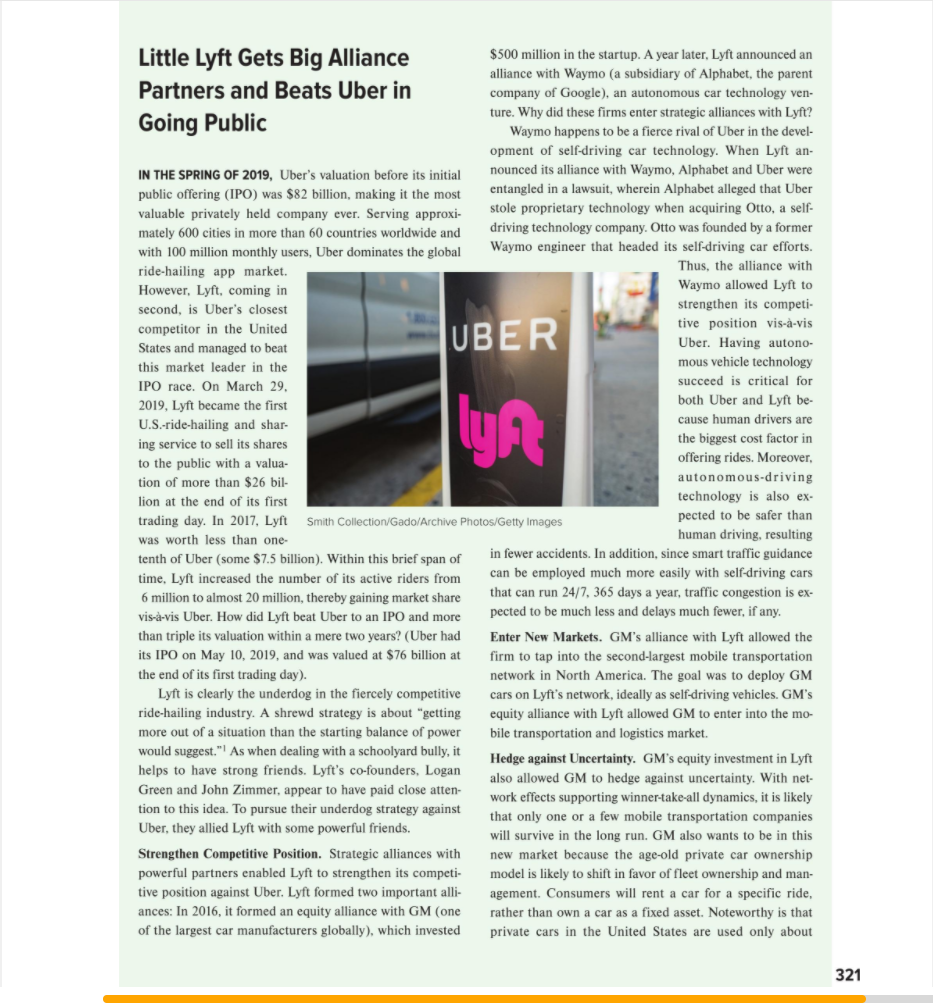GM invested $500 million in Lyft in 2016. What are some possible reasons GM entered an equity alliance with Lyft? Are there any reasons GM would prefer Lyft over Uber as an alliance partner?
Little Lyft Gets Big Alliance $500 million in the startup. A year later, Lyft announced an alliance with Waymo (a subsidiary of Alphabet, the parent Partners and Beats Uber in company of Google), an autonomous car technology ven- Going Public ture. Why did these firms enter strategic alliances with Lyft? Waymo happens to be a fierce rival of Uber in the devel- opment of self-driving car technology. When Lyft an- IN THE SPRING OF 2019, Uber's valuation before its initial nounced its alliance with Waymo, Alphabet and Uber were public offering (IPO) was $82 billion, making it the most entangled in a lawsuit, wherein Alphabet alleged that Uber valuable privately held company ever. Serving approxi- stole proprietary technology when acquiring Otto, a self- mately 600 cities in more than 60 countries worldwide and driving technology company. Otto was founded by a former with 100 million monthly users, Uber dominates the global Waymo engineer that headed its self-driving car efforts. ride-hailing app market. Thus, the alliance with However, Lyft, coming in Waymo allowed Lyft to second, is Uber's closest strengthen its competi- competitor in the United tive position vis-a-vis States and managed to beat UBER Uber. Having autono- this market leader in the mous vehicle technology IPO race. On March 29. succeed is critical for 2019, Lyft became the first both Uber and Lyft be- U.S.-ride-hailing and shar- cause human drivers are ing service to sell its shares the biggest cost factor in to the public with a valua- offering rides. Moreover, tion of more than $26 bil- autonomous-driving lion at the end of its first technology is also ex- trading day. In 2017, Lyft Smith Collection/Gado/Archive Photos/Getty Images pected to be safer than was worth less than one- human driving, resulting tenth of Uber (some $7.5 billion). Within this brief span of in fewer accidents. In addition, since smart traffic guidance time, Lyft increased the number of its active riders from can be employed much more easily with self-driving cars 6 million to almost 20 million, thereby gaining market share that can run 24/7, 365 days a year, traffic congestion is ex- vis-a-vis Uber. How did Lyft beat Uber to an IPO and more pected to be much less and delays much fewer, if any. than triple its valuation within a mere two years? (Uber had Enter New Markets. GM's alliance with Lyft allowed the its IPO on May 10, 2019, and was valued at $76 billion at firm to tap into the second-largest mobile transportation the end of its first trading day). network in North America. The goal was to deploy GM Lyft is clearly the underdog in the fiercely competitive cars on Lyft's network, ideally as self-driving vehicles. GM's ride-hailing industry. A shrewd strategy is about "getting equity alliance with Lyft allowed GM to enter into the mo- more out of a situation than the starting balance of power bile transportation and logistics market. would suggest." As when dealing with a schoolyard bully, it Hedge against Uncertainty. GM's equity investment in Lyft helps to have strong friends. Lyft's co-founders, Logan also allowed GM to hedge against uncertainty. With net- Green and John Zimmer, appear to have paid close atten- work effects supporting winner-take-all dynamics, it is likely tion to this idea. To pursue their underdog strategy against Uber, they allied Lyft with some powerful friends. that only one or a few mobile transportation companies will survive in the long run. GM also wants to be in this Strengthen Competitive Position. Strategic alliances with new market because the age-old private car ownership powerful partners enabled Lyft to strengthen its competi- model is likely to shift in favor of fleet ownership and man- tive position against Uber. Lyft formed two important alli- agement. Consumers will rent a car for a specific ride, ances: In 2016, it formed an equity alliance with GM (one rather than own a car as a fixed asset. Noteworthy is that of the largest car manufacturers globally), which invested private cars in the United States are used only about 321CHAPTERCASE 9 Part II ONE OTHER STRATEGIC reason Lyft entered alliances with autopilot feature-allowing Tesla to rack up billions of miles. GM and Waymo is access to critical complementary assets. As more miles are accrued, more data are collected, which Both Lyft and GM bring critical complementary assets to allows the self-driving software to learn and update, making bear in this alliance. GM has upstream core competencies in the autopilot feature even better. In addition, Tesla is plan- manufacturing cost-competitive and reliable cars at a large scale. ning to roll out a fleet of robo-taxis (autonomous-driving Lyft, in turn, has downstream competencies as the second- Tesla vehicles) by 2021, contingent upon regulatory approval. largest mobile transportation network globally, and with it the This rollout will further increase Tesla's wealth of data ac- data that allow Lyft to deploy AI in order to develop proprietary crued through the miles driven by its vehicles. algorithms to have cars at the right time and at the right price. Much like Google's Android mobile operating system for Alphabet's Waymo, moreover, is an early leader in auton- phones, Waymo provides the software that is the brains be- omous vehicle development. Where Waymo lags Tesla in hind the self-driving car technology, but lacks an opportunity driverless car technology, however, is in miles. In addition to for large-scale deployment, which constrains testing and Tesla owners accruing mileage by driving the cars them- learning. The alliance with Lyft allows Waymo to deploy its selves, they also accrue mileage by using Tesla's innovative self-driving car technology on a large scale. The goal is to








